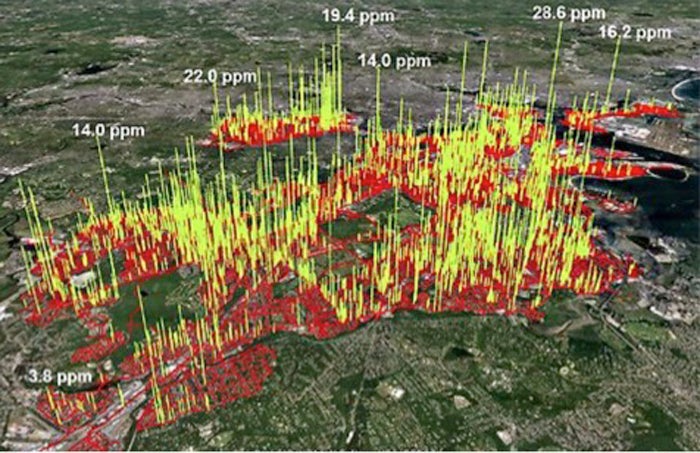Francis Koster: What if your kid said, ‘I believe it’s not dangerous if I can’t see it’
Published 12:00 am Tuesday, January 31, 2023

- This image is of leaking natural gas from underground pipes. Created 10 years ago by Professor Nathan Phillips from Boston University and Professor Robert Jackson of Duke University and a group of students, it shows 3,356 leaks in Boston.
By Francis Koster
You are surrounded by family, friends and neighbors who are people of good will who help you if they saw you were facing an issue like seeing your little kid standing alone in the middle of the street or an angry person waving a baseball bat in the neighborhood. And you would jump in help them if you could see they needed it.
Heading off climate change is not likely to call you to action because you cannot see the invisible threats. The good news is that once you you acknowledge the problem, the solutions are all local.
The latest calculations show us crossing into an area of great worldwide pain and suffering in about 10 years – somewhere around 2030-2035.[i],[ii]
How old will your kids/grandkids be in 2030 – 2035?
One of the major causes of this threat rise is increasing amounts of a gas called methane in the atmosphere right over your head.
Methane (also called “natural gas” because it is made by nature) is not only sneaky because it is invisible, it is dangerous because it is around 80 times more powerful than Carbon Dioxide and does its lifetime damage over about 12 years.[iii] This means if we stop the methane leaks, 12 years later the risk slows.
The United States is the second largest methane emitter in the world. There are three main sources: Leakage from the oil and gas pipelines, landfills and cattle farms.
Gas Pipelines: If we find the sources of leaking natural gas in our communities pipelines and get them plugged, the terrible damage they would have created will be prevented.
These kind of leaks are all around us — and the older the town the more there are.
This would be a great project for area colleges and universities. A good example is underway at Clark University in Worcester, Massachusetts where students lead groups of ciity residents on discovery walks using visual cues and meters to spot leaks. Our area community colleges, colleges, and universities could do that here.
Landfill dumps: The second major target is landfill dumps. All that garbage you put out every week gets put in the ground, rots, and makes methane. Most of North Carolina’s 1,000 landfills operators just let it leak. In some cases they catch it and burn it. A few innovators capture it and use to make electricity.
There are many such projects already in operation, including one at the speedway in Concord. This project is run by Republic Services, which has earned over $50 million since it started. They expect their income to double in the next five years.[v] Another example is Wake County, where a private firm will invest $30 million to capture methane, generate electricity, and spilt the profits with the Wake County.[vi]
With aggressive local leadership we could do it here – and it would not only be an investment with a nice rate of return, it would also make a contribution to lowering the rising risk of climate threats for everyone.
Cattle Farms: In America, about one-third of all methane emissions are from cattle. They eat plants, and pass out methane. There are a number of research projects going on around the world trying to figure out how to fix this. The most promising seems to be adding about a cup of something made from seaweed to their diet (like Gas-X or Mylanta from your neighborhood pharmacy) that reduces the cows production of gas.[vii] Agriculture annually brings almost $146 million to Cabarrus and Rowan County.[viii] Unlike the gas industry, and landfills, which may save money by plugging leaks, the farmer does not get a boost in profit from solving the problem. Good for society and the world, but no incentive for the farmer. That needs to be fixed.
This would be a great project for Ag. Extension to work with some of our state’s research universities and the North Carolina Research Campus on.
Our county, state, and nation are facing a very dangerous situation caused by invisible gasses, but we are not helpless.. The one thing we can be sure of is that we cannot stand around hoping others will fix it. Will you step up and join others to rescue the kids from a life altering threat?
[i] https://www.scientificamerican.com/article/the-world-will-likely-miss-1-5-degrees-c-why-isnt-anyone-saying-so/
[ii] https://www.livescience.com/co2-emissions-not-decreasing
[iii] https://www.unep.org/news-and-stories/story/methane-emissions-are-driving-climate-change-heres-how-reduce-them
[iv] https://archive.nytimes.com/green.blogs.nytimes.com/2012/11/20/methane-is-popping-up-all-over-boston/
[v] https://www.wfae.org/energy-environment/2022-06-30/with-methane-a-climate-worry-landfill-captures-gas-for-energy
[vi] https://www.wakegov.com/news/south-wake-landfill-turn-landfill-gas-renewable-natural-gas
[vii] https://www.edf.org/article/farmers-seek-solutions-methane-emissions-cows
[viii] https://www.nass.usda.gov/Statistics_by_State/North_Carolina/Publications/Annual_Statistical_Bulletin/AgStat/NCAgStatBook.pdf

